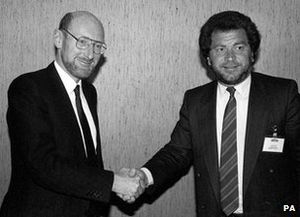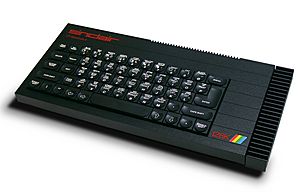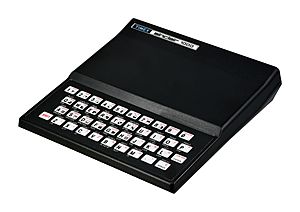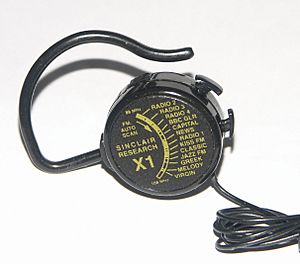Sinclair Research facts for kids
| Limited company | |
| Industry | Computing Electronics |
| Founded | Cambridge, England, UK (1973) |
| Headquarters | London, England, UK |
|
Key people
|
Sir Clive Sinclair, Founder Nigel Searle, Director (1979 to 1986) Jim Westwood Rick Dickinson, Designer |
| Products | Sinclair ZX Spectrum Sinclair QL |
| Revenue | £102 million GBP (1985) |
|
Number of employees
|
140 (1980s) 3 (1990) 1 (1997) |
Sinclair Research Ltd was a British company that made electronics for people to use. It was started by Clive Sinclair in Cambridge, England. The company changed its name a few times. It began in 1973 as Westminster Mail Order Ltd. Later, it became Sinclair Instrument Ltd, then Science of Cambridge Ltd, and Sinclair Computers Ltd. Finally, in 1981, it became Sinclair Research Ltd.
In 1980, Clive Sinclair started selling home computers. His first computer was the ZX80, which cost £99.95. This made it the cheapest personal computer in the United Kingdom at the time. In 1982, the company released the ZX Spectrum. This computer became the best-selling computer in the UK. It was a big competitor to other brands like Commodore and Amstrad.
When the company was very successful, it opened a research center called "MetaLab." This center worked on new ideas like artificial intelligence (AI). But in 1985, two of its products, the Sinclair QL computer and the TV80 pocket TV, did not sell well. This caused the company to have money problems. A year later, in 1986, Sinclair sold the rights to its computer products and brand name to Amstrad. Sinclair Research Ltd continued to exist as a small company, selling Clive Sinclair's inventions until he passed away in 2021.
Contents
History of Sinclair Research
How the Company Started
Clive Sinclair started his first company, Sinclair Radionics Ltd., in Cambridge in 1961. This company made things like radios and calculators. When it looked like Radionics might not do well, Sinclair started a new company in 1973. He first called it Ablesdeal Ltd, then Westminster Mail Order Ltd, and then Sinclair Instrument Ltd in 1975.
In 1976, Clive Sinclair asked Chris Curry to help get Sinclair Instrument running. The company's first product was a Wrist Calculator, which looked like a watch.
Creating the ZX80 Computer
In 1977, Sinclair Instrument Ltd changed its name to Science of Cambridge Ltd. Around this time, an engineer named Ian Williamson showed Chris Curry a very early computer. It was built using parts from a Sinclair calculator. Curry liked the idea and told Sinclair to make it a product. In 1978, Science of Cambridge released this computer as the MK14. You could buy it as a kit to build yourself.
In 1979, Jim Westwood, Sinclair's main engineer, designed a new computer. It used a special chip called the Zilog Z80 microprocessor. Sinclair Instrument Ltd launched this computer as the ZX80 in February 1980. You could buy it as a kit or already built.
Later in 1979, Science of Cambridge Ltd changed its name again to Sinclair Computers Ltd.
Big Success with Home Computers

In March 1981, Sinclair Computers became Sinclair Research Ltd. Soon after, the Sinclair ZX81 computer was launched. In February 1982, a company called Timex Corporation got permission to make and sell Sinclair's computers in the United States. They sold them under the name Timex Sinclair. In April 1982, the famous ZX Spectrum computer was released.
The ZX Spectrum became very popular. In 1982, Sinclair Research Ltd made a profit of £8.55 million. This included money from a government grant to help develop a flat screen.
In 1982, Clive Sinclair turned an old water bottling factory in Cambridge into the company's new main office.
In January 1983, the ZX Spectrum was shown at a big electronics show in Las Vegas. In September, the TV80 pocket television was launched. However, it did not sell well.
The company bought a large building called Milton Hall in 1983. They spent £2 million to turn it into their MetaLab research and development center.
By late 1983, Timex decided to stop selling Timex Sinclair computers in the United States. There was too much competition. However, Timex computers were still made and sold in other countries for a few more years.
Mid-1980s Challenges
The Sinclair QL computer was announced in January 1984. It was meant to be a more advanced computer for business users. But the QL had many problems. It had design flaws and was difficult to find good reviews for.
The QL computers were not ready to ship until late summer. Many people complained about the delays. The company had also been criticized for delays in shipping the Spectrum computers in 1982. People were especially upset that Sinclair was cashing their checks months before sending the computers. QL production stopped in February 1985, and its price was cut in half by the end of the year.
The ZX Spectrum+, which was a ZX Spectrum 48K with a new keyboard, came out in October 1984. Stores bought many of them, hoping for good Christmas sales. But it did not sell as well as expected. This caused Sinclair's income to drop. The Spectrum+ had the same inside parts as the original Spectrum. An improved model, the ZX Spectrum 128, was launched in Spain in September 1985. Its release in the UK was delayed until January 1986.
In January 1985, Sinclair tried to sell products in the United States again. They announced the "FM Wristwatch Radio." This was a watch with a radio. But it had problems and was never fully produced.
Clive Sinclair was also very interested in electric vehicles. In 1983, he started a company called Sinclair Vehicles Ltd. He launched the Sinclair C5 electric vehicle in January 1985. But it was a big failure. Only 17,000 units were sold, and Sinclair lost £7 million. Sinclair Vehicles closed down later that year. The failure of the C5, along with the QL and TV80, made investors lose trust in Sinclair.
Amstrad Buys Sinclair's Computer Business

Sinclair Research had planned to sell shares to the public in March 1985. But this was put off because of problems in the computer industry.
On May 28, 1985, Sinclair Research said it needed to raise £10 million to £15 million to reorganize. But because people had lost trust in the company, it was hard to find the money. In June 1985, a rich businessman named Robert Maxwell announced he would buy Sinclair Research. However, this deal fell apart in August 1985.
The future of Sinclair Research was uncertain until April 7, 1986. On this date, the company sold all its computer products and the "Sinclair" brand name to Amstrad for £5 million. The deal did not include the Sinclair Research company itself, only its computer business.
New Directions and Later Years
After the Amstrad deal, Sinclair Research became a company focused on R&D. It also held shares in new "spin-off" companies. These companies used technologies that Sinclair had developed.
Since 1986, the company has continued to exist, but in a much smaller way. By 1990, the company had only three employees: Clive Sinclair, a salesman, and one R&D employee. By 1997, only Clive Sinclair himself was working at the company.
In 1992, the "Zike" electric bicycle was released. This was Sinclair's second try at changing how people travel. It could go up to 10 mph (16 km/h). Like the C5, the "Zike" did not sell well. Only 2,000 units were sold. In 1999, Sinclair released the world's smallest radio, called the "Z1 Micro AM Radio."
In 2003, the Sinclair "ZA20 Wheelchair Drive Unit" was launched. This was a motor for wheelchairs. In July 2006, the A-bike was released. This was a folding bicycle invented by Sinclair. In November 2010, Sinclair Research announced the X-1, a two-wheel electric vehicle, but it was never produced.
Sinclair Products
Here are some of the products Sinclair Research and its earlier versions created:
- Wrist Calculator: This was a calculator that looked like a watch. It was released in 1977.
- Multimeter DM2: A device with an LED screen that measured electricity. It came out in 1975.
- MK14: This was a computer kit that you could build yourself. It was sold by Science of Cambridge in 1977 for £39.95.
- ZX80: This home computer was launched in February 1980. It cost £79.95 as a kit or £99.95 already built.
- ZX81: The ZX81 was released in 1981. In the United States, it was known as the TS 1000. It was sold by mail order.

- ZX Spectrum: The ZX Spectrum was launched on April 23, 1982. It came in two versions: one with 16 KB of memory for £125 and one with 48 KB for £175.
- TV80: This was a small pocket television. It came out in September 1983. It did not sell well, only about 15,000 units.
- Sinclair QL: The Sinclair QL was announced in January 1984. It cost £399. It was designed to be a more advanced computer for professionals. However, it had many problems with its design and software.
- ZX Spectrum+: This was a ZX Spectrum 48K computer with a new look and keyboard. It was launched in October 1984.
- ZX Spectrum 128: This version of the Spectrum had more memory (128 KB) and a sound chip. It was launched in Spain in September 1985 and in the UK in January 1986.
- Computer Add-ons: Sinclair also made many extra parts for its computers. These included memory upgrades and devices like the ZX Printer. For storing information, the Spectrum usually used cassette tapes. Sinclair also offered its own storage system called the ZX Microdrive.
- X1 Button FM Radio: In June 1997, Sinclair Research released this tiny FM radio for £9.50. It was very small and fit into your ear.
Projects That Were Not Released
Sinclair Research worked on several computer projects in the 1980s that were never fully produced:
- LC3: This stood for "Low Cost Colour Computer." It was meant to be a cheap game console. The project was stopped in 1983 in favor of the Sinclair QL.
- SuperSpectrum: This was planned to be a powerful home computer with a faster processor and built-in features. It was cancelled in 1982.
- Pandora: This was going to be a portable computer with a flat screen. It was cancelled after Amstrad bought the computer business. However, the idea later led to the Z88 portable computer.
- Loki: This project aimed to create a much better ZX Spectrum, possibly as good as the Commodore Amiga. It was planned to have a faster processor and improved graphics and sound.
- Tyche: This was a follow-up project for the QL computer. It was meant to have more memory and built-in floppy disk drives.
- Sinclair X-1: In 2010, Sinclair announced a new electric vehicle called the X-1. It was a two-wheel vehicle. It was supposed to be available in 2011, but it was never produced.
|
See also
 In Spanish: Sinclair Research para niños
In Spanish: Sinclair Research para niños
- Sinclair BASIC
- Sinclair C5
- Sinclair Executive
- Sinclair Radionics
- Sinclair Scientific
- Sinclair Vehicles
- Timex Sinclair
- TV80
- Sinclair President



